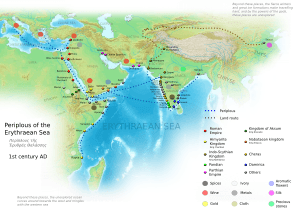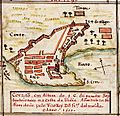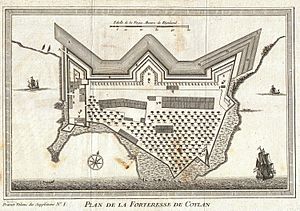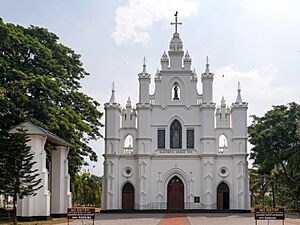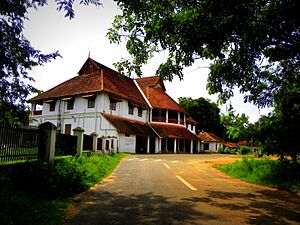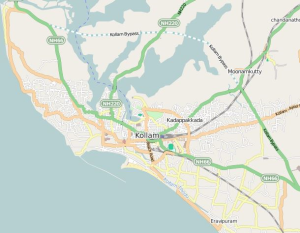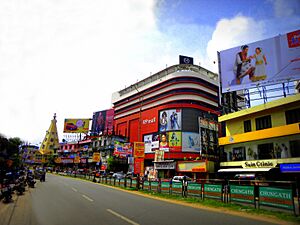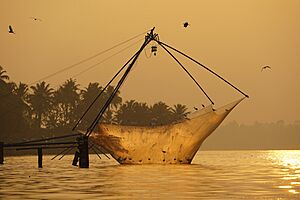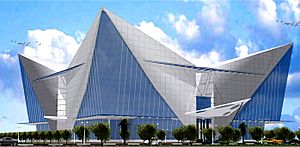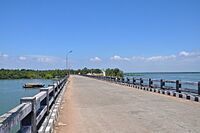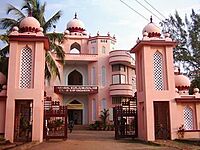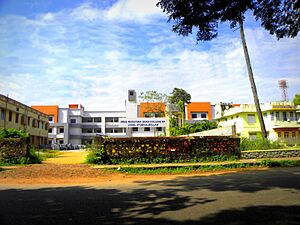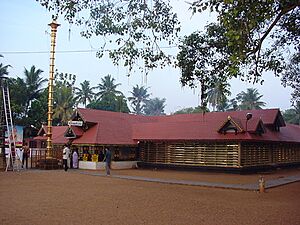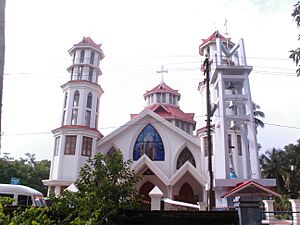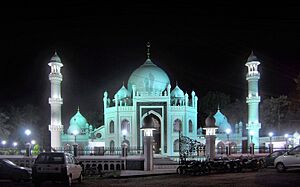Kollam facts for kids
Quick facts for kids
Kollam
Quilon
|
|
|---|---|
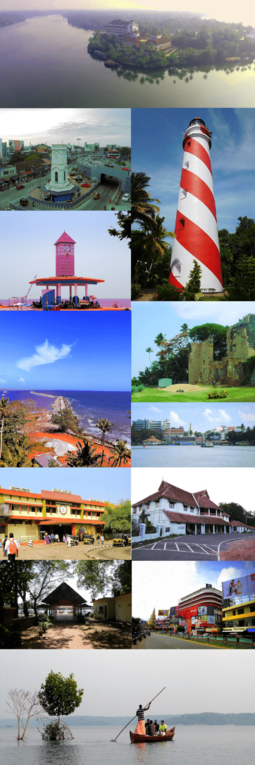
From top clockwise:An aerial view of the Ashtamudi Lake & The Raviz, Thangasseri Lighthouse, Ruins of St Thomas Fort, Kollam KSRTC bus station & KSWTD Boat Jetty, British Residency, Downtown Kollam area including RP Mall, Tourists in Munroe Island, Adventure Park, Kollam Junction railway station, Break Water Tourism & Kollam Port, Kollam Beach and Chinnakada Clock Tower
|
|
| Etymology: Black pepper: kola ("black pepper") | |
| Nickname(s):
"Prince of Arabian sea"
"Cashew Capital of the World" "The Gateway to Backwaters" "Fountain of Youth" |
|

Location of the city within Kollam Metropolitan Area
|
|
| Country | |
| Region | South India |
| State | Kerala |
| District | Kollam |
| Former Name | Quilon, Desinganadu, Venad, Columbum, Kaulam (see Names for Kollam) |
| Native Language | Malayalam |
| Established | 1099 |
| Founded by | Rama Varma Kulashekhara |
| Boroughs | 7 Zones: Central Zone-1, Central Zone-2, Eravipuram, Vadakkevila, Sakthikulangara, Kilikolloor, Thrikadavoor |
| Government | |
| • Type | Mayor–Council |
| • Body | Kollam Municipal Corporation |
| Area | |
| • Metropolis | 165 km2 (64 sq mi) |
| Area rank | 4 |
| Elevation | 38.32 m (125.72 ft) |
| Population
(2021)
|
|
| • Metropolis | 1,342,509 |
| • Rank | 5 (41th IN) |
| • Density | 8,136/km2 (21,070/sq mi) |
| • Metro | 1,871,086 |
| Demonym(s) | Kollamite, Kollathukaaran/kaari, Kollamkaran/kaari |
| Languages | |
| • Official | Malayalam English |
| Time zone | UTC+5:30 (IST) |
| PIN |
691 XXX
|
| Telephone code | +91474xxxxxxx |
| Vehicle registration | Kollam- KL 02, Karunagapally- KL 23, Kottarakkara- KL 24, Punalur- KL 25, Kunnathur- KL 61, Pathanapuram- KL 80, Chadayamangalam- KL 82 |
| HDI | High |
| Literacy | 91.18% |
| UN/LOCODE | IN QUI IN KUK |
Kollam (Malayalam: [kolːɐm]), also known as Quilon, is an old port city in the Indian state of Kerala. It is the fourth largest city in Kerala. Located on the southern coast of India, Kollam sits by the Ashtamudi Lake. It is about 71 kilometers (44 miles) northwest of Thiruvananthapuram, the state capital.
Kollam is one of India's oldest cities where people have lived continuously for a very long time. There is proof of people living here since the Stone Age. The city has been a busy trading port for thousands of years. Ancient groups like the Phoenicians and Romans traded here. Kollam is known as the southern entry point to the beautiful Kerala backwaters. It is also famous for processing cashews, making coir (coconut fiber), and its growing tourism industry.
Kollam has always been important for trade. People from Arabia, China, Ethiopia, Syria, and Rome traded at Kollam's port for centuries. In the 14th century, a famous traveler named Ibn Battuta said Kollam was one of the five most important Indian ports he had seen. Chinese traders even had a settlement in Kollam. The Venetian traveler Marco Polo also visited Kollam in 1275. Kollam is home to one of the seven churches believed to be started by Thomas the Apostle. It also has one of the ten oldest mosques in Kerala, thought to be founded by Malik Deenar.
In 822 AD, two bishops from Syria, Mar Sabor and Mar Proth, came to Quilon with their followers. Two years later, in 824 AD, the Malabar Era (a calendar system) began, and Quilon became the most important city in the Malabar region. The Kollam Port was started in 825 AD. The first book printed in an Indian language, Thambiran Vanakkam, was published in Kollam on October 20, 1578.
Kollam city has received a special quality certificate (ISO 9001:2015) for its city services. A study in 2020 found that Kollam was the tenth fastest-growing city in the world. It grew by 31.1% between 2015 and 2020. Kollam is one of the least polluted cities in India. It is also known for having a very high number of females compared to males among India's largest cities.
During the later years of the Chera dynasty, Kollam became a key center for trade and politics. Today, it remains a major business hub in Kerala. Four important trading towns near Kollam are Kottarakara, Punalur, Paravur, and Karunagapally.
Contents
What's in a Name?
In 825 CE, the Malayalam calendar, also called Kollavarsham, was created in Kollam. This calendar is said to have started when the city was rebuilt after a big fire.
The city was known by different names throughout history. Arabs called it Koolam, the Portuguese called it Coulão, and in old Tamil writings, it was known as Desinganadu.
Kollam's Past
Kollam, known as Quilon in ancient times, was a busy port during the Pandya dynasty (around 3rd century BC to 12th century). Later, it became the capital of the independent Venad kingdom, founded around 825 CE. In the 13th century, Kollam was considered one of the four most important trading ports in the world. The others were Alexandria and Cairo in Egypt, Quanzhou in China, and Malacca in Malaysia. Trade in Kollam was so strong that in 1280, envoys from China's Yuan dynasty came to Kollam to build ties with the local ruler.
Early Rulers and Trade
The history of Kollam was quite separate from the rest of Kerala for a long time. While the Chera dynasty ruled much of the Malabar Coast, the southern part of Kerala, where Kollam is, was under the Ay dynasty. The Ay dynasty was more connected to the Pandya dynasty of Madurai.
Kollam was a major port for the Pandya dynasty on the western coast. It had a strong trading reputation even from the time of the Phoenicians and ancient Romans. Writers like Pliny the Elder mentioned Greek ships docking at ports like Muziris and Nelcynda. Goods like spices, pearls, diamonds, and silk were sent from these ports to Egypt and Rome.
In 550 AD, a Greek sailor named Cosmas Indicopleustes visited the Malabar Coast. He wrote about Christian communities there, mentioning a church in Male (Malabar Coast). Kollam is also home to one of the oldest mosques in India. It is believed that many mosques, including the one in Kollam, were built during the time of Malik Dinar in the 7th century.
Capital of Venad (9th to 12th centuries)
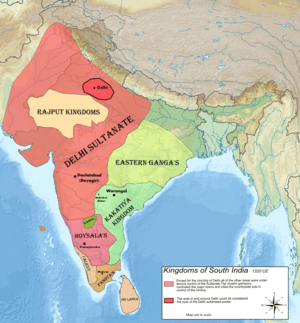
The port of Kollam was founded in 825 AD by Nestorian Christians, Mar Sabor and Mar Proth. They had permission from Ayyanadikal Thiruvadikal, the king of the Venad kingdom.
The king gave Christians special rights to manage foreign trade in the city. This helped Kollam's trade and wealth grow. This period also marked the start of the Malayalam Era, known as Kolla Varsham, named after the city. This shows how important Kollam was in the 9th century. A Persian merchant named Soleyman of Siraf visited Malabar in the 9th century. He noted that Quilon was the only port in India where huge Chinese ships came to transfer goods.
Kollam as "Colombo" in the Catalan Atlas (1375)

In the 13th century CE, a Pandya ruler named Maravarman Kulasekara Pandyan I fought a war in Venad and captured Kollam. The city appears on the Catalan Atlas map from 1375 CE as Columbo and Colobo. This map shows Kollam as a Christian city ruled by a Christian king.
The text on the map next to the king says:
Açí seny[o]reja lo rey Colobo, christià. Pruvíncia de Columbo
(Here reigns the Lord King Colobo, Christian, Province of Columbo).
Merchants from Genoa visited the city often in the 13th and 14th centuries. In 1329 CE, Pope John XXII made Kollam the first Roman Catholic bishopric (a church district led by a bishop) in India. He appointed Jordan of Catalonia as the first bishop.
European Influence (16th to 18th centuries)

The Portuguese arrived in India in 1498. They were the first Europeans to set up a trading center in Tangasseri, Kollam, in 1502. This became their main place for trading pepper. In 1517, the Portuguese built the St. Thomas Fort in Thangasseri, but it was later destroyed by the Dutch.
In 1661, the Dutch East India Company took control of the city. You can still see parts of the old Portuguese Fort, which the Dutch later fixed up, in Thangasseri. In the 18th century, the kingdom of Travancore took over Kollam. Then, the British took control in 1795. Thangasseri is still known as an Anglo-Indian settlement today. The Infant Jesus Church in Thangasseri, an old Portuguese church, reminds us of their rule.
Battle of Quilon
The Battle of Quilon happened in 1809. It was fought between the Indian kingdom of Travancore and the British East India Company. The battle lasted only six hours. The British forces won, and those who fought against them were punished.
Travancore Rule
In the early 18th century, the Travancore royal family took over the Venad Kingdom, and Kollam became its capital. Later, the capital was moved to Thiruvananthapuram. Travancore became the strongest state in Kerala. The government offices were in Kollam until the 1830s, when they moved to Thiruvananthapuram.
Discoveries at Kollam Port
Since February 2014, archaeologists have been digging at the Kollam Port. They have found many old items, including Chinese porcelain and coins. These discoveries show that Kollam had strong trade links with ancient China.
Kollam's Geography
Kollam city is surrounded by different areas: Neendakara and Thrikkaruva to the north, Mayyanad to the south, and Thrikkovilvattom and Kottamkara to the east. To the west is the Laccadive Sea. The beautiful Ashtamudi Lake is right in the middle of the city.
Kollam is about 71 kilometers from Thiruvananthapuram and 140 kilometers from Kochi. The National Waterway 3 and the Ithikkara River are important waterways that pass through the city. The 7.7-kilometer long Kollam Canal connects Paravur Lake and Ashtamudi Lake.
In March 2016, IndiaTimes named Kollam one of the nine least polluted cities in the world. Also, in 2020, Booking.com travelers chose Kollam as one of the top 10 most welcoming places in India.
Kollam has always been a trading town, trading with Romans, Chinese, and Arabs. Old Roman coins found here support this history. There was also trade through the Aryankavu Pass to Tamil Nadu. The city grew into an early industrial center because of trade in pepper and connections through waterways. Today, it is known for processing cashews and making coir. Ashtamudi Lake is a popular tourist spot and is seen as the southern entry to Kerala's backwaters.
Climate
Kollam has a tropical monsoon climate. This means temperatures don't change much throughout the year. From December to March is the dry season, with very little rain. From April to November is the wet season, with much more rain, especially in June and July during the Southwest Monsoon.
| Climate data for Kollam | |||||||||||||
|---|---|---|---|---|---|---|---|---|---|---|---|---|---|
| Month | Jan | Feb | Mar | Apr | May | Jun | Jul | Aug | Sep | Oct | Nov | Dec | Year |
| Mean daily maximum °C (°F) | 31 (88) |
31 (88) |
32 (90) |
32 (90) |
31 (88) |
29 (84) |
29 (84) |
29 (84) |
29 (84) |
30 (86) |
29 (84) |
30 (86) |
30 (86) |
| Mean daily minimum °C (°F) | 23 (73) |
23 (73) |
25 (77) |
26 (79) |
25 (77) |
24 (75) |
24 (75) |
24 (75) |
24 (75) |
24 (75) |
24 (75) |
23 (73) |
24 (75) |
| Average rainfall mm (inches) | 18 (0.7) |
26 (1.0) |
53 (2.1) |
147 (5.8) |
268 (10.6) |
518 (20.4) |
381 (15.0) |
248 (9.8) |
209 (8.2) |
300 (11.8) |
208 (8.2) |
51 (2.0) |
2,427 (95.6) |
| Average rainy days (≥ 0.1 mm) | 1 | 2 | 4 | 8 | 11 | 21 | 19 | 16 | 12 | 12 | 8 | 3 | 117 |
| Source: Weather2Travel | |||||||||||||
People of Kollam
Population
As of 2011[update] India census, Kollam city had a population of 349,033 people. For every 1,000 males, there were 1,112 females, which is the highest in Kerala. Kollam city ranks fourth in population in the state. As of 2010, Kollam had a high literacy rate of 93.77%, meaning most people can read and write. About 11% of the population was under six years old. In 2015, the city's area expanded, and its population grew to 384,892.
Malayalam is the main language spoken and the official language. Some people also understand Tamil. There are also small groups of Anglo-Indians, Konkani people, Telugu people, and Bengali workers living in the city. For easier management, Kollam city is divided into six zones, each with its own local office.
Religions
| Religion in Kollam City (2011) | ||||
|---|---|---|---|---|
| Religion | Percentage | |||
| Hinduism | 56% | |||
| Islam | 22% | |||
| Christianity | 21% | |||
| Others | 1% | |||
| Distribution of religions †Includes Not Stated, Sikhism (<0.01%), Buddhism (<0.01%). |
||||
Kollam city is a mix of different religions, cultures, and languages. There are many old temples, churches, and mosques in and around the city. Most people in Kollam are Hindu, making up 56.35% of the population. The Kollam Era (or Malayalam Calendar) started in Kollam city in 825 CE.
Muslims make up 22.05% of Kollam's population. The Karbala Maidan and Makani mosque are important places for Muslim prayers. The 300-year-old Juma-'Ath Palli at Karuva holds the remains of a Sufi saint.
Christians make up 21.17% of Kollam's population. The Roman Catholic Diocese of Quilon (Kollam) was the first Catholic diocese in India, created in 1329. The famous Infant Jesus Cathedral, built 400 years ago in Thangassery, is an important Catholic church. The CSI Kollam-Kottarakara Diocese is also based here.
City Management
Kollam City is run by a Municipal Corporation. This group has elected Councillors from its 55 areas. The Mayor, chosen by the councillors, usually belongs to the political party with the most members. The Corporation Secretary is in charge of the corporation's office.
The city's police force is led by the Kollam City Police Commissionerate. This office is headed by an IPS officer, who reports to the Inspector General of Police. The police force is part of the Kerala Government's Home Department. Kollam City is divided into three police areas: Karunagappally, Kollam, and Chathannoor.
City Growth
With a total urban population of over 1.1 million people, Kollam is the fourth most populated city in Kerala. It is also the 49th most populated urban area in India. In 2011, the city's urban growth rate was the second highest in the state. The Kerala Government plans to develop Kollam as a "Port City of Kerala." This project will include building facilities for fishing, tourism, and entertainment.
Kollam's Economy
Kollam's city life has changed a lot recently. In terms of money earned per person, Kollam city ranks fifth in India and third in Kerala. Kollam is known for its strong export business. Many new hotels, shopping malls, and showrooms for jewelry, textiles, and cars have opened in the city. Kollam was the third city in Kerala to have shopping malls. The Downtown Kollam area is the main business center.
Dairy farming is well developed here, and there is a chilling plant for milk. Kollam is an important port city. Fishing is a big part of the local economy. Villages like Neendakara and Sakthikulangara are known for their fisheries. About 135,000 people work in fishing and related jobs. One-third of Kerala's total fish catch comes from Kollam. Nearly 3,000 motorized boats operate from the fishing harbor.
There are also important government-owned industries in Kollam, such as Indian Rare Earths and Parvathi Mills Ltd. Other major industries include Aluminium Industries Ltd. and Kerala Ceramics Ltd. The beaches in the district have valuable minerals like Ilmenite and Rutile. Kollam also has large deposits of China clay and lime-shell.
Kollam is known as the "Cashew Capital of the World." It has over 600 cashew-processing factories. Every year, about 800,000 tonnes of raw cashews are brought to the city for processing. About 130,000 tonnes of processed cashews are then sent to countries all over the world. The Kerala State Cashew Development Corporation Limited (KSCDC) is located in Kollam city and owns many cashew factories.
Kollam is also a major hub for exporting seafood in India. Many companies in areas like Maruthadi and Neendakara are involved in this business.
The clam fishery in Kollam's Ashtamudi Lake was the first in India to receive a special certification for being sustainable. This clam fishery supports about 3,000 people who collect, clean, process, and trade clams. The lake is home to about 90 types of fish and ten types of clams.
Culture and Festivals
Kollam Fest is an annual festival in Kollam. It attracts many people from Kerala and also tourists from other parts of India and the world. The main events of Kollam Fest happen at the large Ashramam Maidan. This festival shows off Kollam's rich culture, history, and its potential for tourism and new businesses.
Kollam Pooram is a big festival that is part of the Asramam Sree Krishna Swamy Temple Festival. It usually takes place around April 15th or 16th at the Ashramam maidan.
The President's Trophy Boat Race (PTBR) is a yearly boat race held in Ashtamudi Lake. This event was started by President Prathibha Patil in September 2011.
Getting Around Kollam
By Air
The closest airport to Kollam city is the Trivandrum International Airport. It is about 56 kilometers away. This airport was the first international airport in India that was not in a major metro city.
By Rail
Kollam Junction railway station is the second largest railway station in Kerala. It has 6 platforms and 17 train tracks. Kollam Junction also has the world's third longest railway platform, measuring 1180.5 meters (3873 feet).
There is a special shed at Kollam Junction for maintaining MEMU (Mainline Electrical Multiple Unit) trains. MEMU services started from Kollam to Ernakulam in January 2012. Later, services also began between Kollam and Nagercoil. The Kollam MEMU Shed, opened in December 2013, is the largest and most modern MEMU shed in Kerala.
By Road
Kollam city is well connected by roads to almost all major towns and cities in Kerala. These include Trivandrum, Alappuzha, and Kochi. It is also connected to other Indian cities by national highways like NH 66, NH 183, and NH 744.
Public road transport is provided by the state-owned Kerala State Road Transport Corporation (KSRTC) and private bus companies. Kollam is one of the five KSRTC zones in Kerala. You can also find private taxis and auto-rickshaws (autos) for transport. There is a private bus stand at Andamukkam and a KSRTC bus station next to Ashtamudi Lake. Buses from here go to various towns in Kerala and other states.
By Water
The Kerala State Water Transport Department runs boat services from the Kollam KSWTD Ferry Terminal. You can take boats to places like West Kallada, Munroe Island, and Alappuzha.
Double-decker luxury boats travel between Kollam and Allepey every day. During the tourist season, luxury boats also operate from the main boat jetty. The West Coast Canal system, which runs from Thiruvananthapuram to the north, passes through Kollam.
Kollam Port is the second largest port in Kerala, after Cochin Port Trust. It is one of two international ports in Kerala. Cargo handling started here in 2013. Foreign ships regularly arrive at the port. Once the port is fully operational, it will make it easier for Kollam's cashew companies to transport their goods.
Learning and Education
Kollam has many respected colleges, schools, and learning centers. The Thangal Kunju Musaliar College of Engineering was the first private engineering college of its kind in Kerala. It is located about 7 kilometers east of Kollam city. Fatima Mata National College and Sree Narayana College are other important colleges. There are also two law colleges in the city. Some of the best schools in Kollam include Trinity Lyceum School and Infant Jesus School.
The Kerala State Institute of Design (KSID) is a design institute located in Chandanathope, Kollam. It was one of the first government-owned design institutes in India, started in 2008. The Indian Institute of Infrastructure and Construction (IIIC-Kollam) is an international-standard institute in Chavara. It helps people develop skills for construction jobs. The Institute of Fashion Technology, Kollam is also located here.
Kollam is known as India's center for coaching classes for bank exams. There are about 40 such institutes in the district. Students from many other Indian states come here for coaching.
Sports in Kollam
Cricket is the most popular sport in Kollam, followed by hockey and football. Kollam has many local teams that play in district, state, and zone matches.
There is an International Hockey Stadium with an artificial turf field in Asramam. It cost about Rs. 13 crore to build. The city also has another stadium called the Lal Bahadur Shastri Stadium. This stadium is used for many sports events, including important national games. Two open grounds in the city, the Asramam Maidan and Peeranki Maidan, are also used for sports and practice.
Places to Visit
- Palaruvi Falls
- Munroe Island
- Shenduruny Wildlife Sanctuary
- Ashtamudi
- Paravur
- Jatayu Earth's Center Nature Park
- Kollam Beach
- Thenmala
- Thirumullavaram
- Thangassery
- Adventure Park, Kollam
- Thevally Palace
- Punalur
- Aryankavu
- Oachira
- Sasthamcotta lake
- Sambranikodi island
- Puthenkulam
- Polachira
- Kottukal Cave Temple
- Kumbhavurutty Waterfalls
- Azheekal Beach
- Rosemala
Places of Worship
- Hindu Temples
- Anandavalleeshwaram Sri Mahadevar Temple is a 400-year-old Hindu temple in the city.
- Ammachiveedu Muhurthi temple was founded about 600 years ago by the Ammachi Veedu family.
- The Kollam pooram, a major festival, is held at the Asramam Sree Krishna Swamy Temple usually in mid-April.
- Kottankulangara Devi Temple is a very famous Hindu temple in Kerala.
- Other well-known Hindu temples in the Kollam area include Kottarakkara Sree Mahaganapathi Kshethram in Kottarakkara, Puttingal Devi Temple in Paravur, and Sasthamcotta Sree Dharma Sastha Temple in Sasthamkotta.
- Christian Churches
The Infant Jesus Cathedral in Tangasseri was built by the Portuguese in 1614. It is now a co-cathedral of the Roman Catholic Diocese of Quilon, which is the oldest Catholic diocese in India. The church reminds us of the Portuguese rule in old Quilon city. St. Sebastian's Church at Neendakara is another important church. The Dutch Church in Munroe Island was built by the Dutch in 1878. Our Lady of Velankanni Shrine in Cutchery is also an important Christian worship place in Kollam.
- Muslim Mosques
Some of the major mosques in Kollam include Kottukadu Juma Masjid in Chavara, Valiyapalli in Jonakappuram, Chinnakada Juma Masjid, and Juma-'Ath Palli in Kollurvila.
Famous People from Kollam
- List of people from Kollam
See also
 In Spanish: Kollam para niños
In Spanish: Kollam para niños




